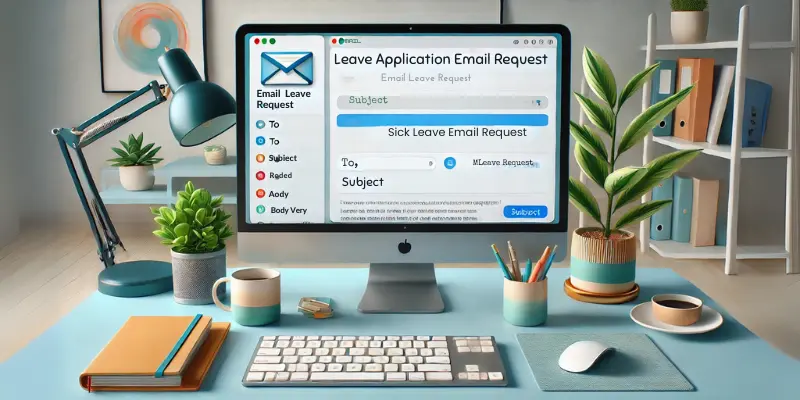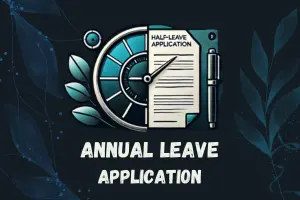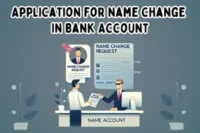How to Write a Clear and Professional Leave Application Email: Simple Steps & Tips
Published: 26 Dec 2024
A leave application email is more than just a request for time off; it’s an important part of professional communication. When you request leave, you’re showing respect for your workplace and your colleagues. A well-written leave application helps you maintain a good relationship with your employer, showing you are organized and considerate of the team’s needs. For personal, sick, or emergency reasons, leaving a clear record ensures everyone knows your plan and can adjust accordingly.
Purpose of the Blog Post
In this post, we will show you how to write a leave request email clearly and politely.
What to include in Your Leave Email:
Basic Information
To ensure your leave application is clear and professional, always include the following details:
- Your Name: Begin by identifying yourself, especially if you’re sending the email to someone who may not know you well. This helps the recipient quickly understand who the request is from.
- Leave Dates: Specify the exact dates you plan to be absent. This helps the employer plan for your absence and manage work accordingly.
- Reason for Leave: Give a simple explanation for your absence without going into unnecessary details. You don’t need to overshare personal information, but a brief reason (e.g., due to illness or for personal matter) is enough.
Tone and Formality
It’s essential to strike the right balance between being professional and approachable in your leave email. Maintain a respectful tone throughout the message. While the language should be formal, it can still be friendly. Keep the email brief and to the point.
- Example: “Respected [Manager Name], I hope this message finds you well. I am requesting leave from [Start Date] to [End Date] due to [Brief Reason]. Thank you for your understanding.”

Key Elements of a Medical Leave Email
Follow these simple steps to write a professional and polite leave application email.
Subject line:
The subject line is the first thing the recipient sees, so it’s important to keep it clear and direct. A concise subject line ensures your email is noticed and understood at first glance. A good subject line lets the recipient know immediately the purpose of the email.
Example:
- “Request for Medical Leave:”
This subject line is simple and includes necessary information, making it easy for the recipient to prioritize your email.
Salutation
The salutation sets the tone of your email. It should be polite and respectful. Depending on your relationship with the recipient, choose a formal greeting.
Formal options:
- Respected [Recipient’s Name],
- Dear [Recipient’s Name],
These greetings show respect and professionalism, especially in a formal work or school setting.
Body of the Email
The body of the email is where you explain your situation in a straightforward, respectful manner. Keep the content simple and clear.
- State your reason for leaving: Mention why you’re requesting medical leave. It could be for an illness, treatment, or recovery period.
- Example: “I am writing to request medical leave due to a sudden illness.”
- Mention the duration of leave: Specify the exact dates for your absence. This ensures clarity regarding the start and end of your leave.
- Example: “I will be leaving from [Start Date] to [End Date].”
- Assure responsibility: Reassure the recipient that you’ve arranged for your work or tasks during your absence. This shows responsibility and keeps your professional reputation intact.
- Example: “I have informed my team about my absence and delegated tasks to [colleague’s name]. I will catch up on my missed work as soon as I return.”
Closing and signature
End your email with a polite closing and professional signature. This is a positive impression and ensures that all necessary information is included.
- Professional closings:
- “Sincerely”
- “Thank you for your understanding,”
- “Best regards”
- Signature: After the closing, add your full name and, if needed, your contact details. This makes it easy for the recipient to reach if necessary.
- Example:
- “Sincerely
- [Your Full Name]
- [Your Job Title]
- [Your Contact Information]”
Professional Leave Application Email Template
Learn how to write a leave request email with a polished and effective template for clear communication.
| Here’s an example of how to write an email for a leave application: |
|---|
Date: December 00, 2025 Subject: Request for Leave (Mention Reason), Respected [Rceipient Name], I hope this email finds you well. I am writing to formally request leave from work for the period [Start Date] to [End Date]. The reason for my leave is [briefly explain the reason, such as personal issues, medical appointments, family matters, etc.]. I have to make sure that my all pending tasks are either completed or delegated. [Optional]: Include details about handover, e.g., “I have discussed the task with [colleague’s Name], who has agreed to assist during my absence.” If approved, I will make sure to complete any pending tasks before my leave begins and remain available for urgent matters via [Preferred Communication Method, e.g., Email, Phone]. Please let me know if there are any forms or additional steps I need to complete for the leave request. Thank you for considering my request. I appreciate your understanding and support. Looking forward to your approval. Best regarding, [Your Full Name] [Your Position] [Your Contact Information] |
This template is fully customizable feel free to modify it according to your specific needs, such as adjusting the tone, duration, or additional details required for your leave request.
Tips for Writing a Good Leave Application Email
Here are some practical tips to help you write a clear and professional leave application email:
| Here are some tips for a good leave email request: |
|---|
Be Honest and Clear Always provide an honest reason for your leave. It’s important to be transparent with your employer, as this builds trust and ensures there are no misunderstandings. Stick to the facts without oversharing personal details. Use a Professional Email Address Make sure you’re sending your leave request from a professional email address, ideally one that matches your workplace or personal brand. Avoid using informal email addresses or nicknames, as this may seem unprofessional. Proofread Before Sending Before hitting send, take a moment to proofread your email. Check for spelling and grammar mistakes, as errors can make you appear careless. A well-written email shows attention to detail and respect for the reader. Keep it, Beirf Your email should be short, direct, and to the point. Employers appreciate clear communication and focus on the essential details: dates, the reason for leave, and any necessary arrangements. Avoid lengthy explanations or unnecessary information. |
By following these tips, you’ll ensure that your leave application email is professional and respectful.
For More Applications, Visit These Pages:
Sick Leave Applications Email: https://myapplicationsformats.com/sick-leave-email-guide/
Half-Day Leave Application: https://myapplicationsformats.com/half-day-leave-application-for-office-employees/
Casual Leave Application: https://myapplicationsformats.com/how-to-write-casual-leave-application/
Conclusion:
Recap of Key Points
To write an effective leave application email remember these main steps:
- Start with a clear subject line.
- Use a respectful greeting.
- Mention the dates for your leave.
- Keep your reason brief and professional.
- Offer a plan for work during your absence (if applicable).
- End with a polite and appreciative closing.
Final Tip: Keep it Professional
Always maintain professionalism when writing your leave email. Being clear, respectful, and brief will help ensure your request is well-received. Whether it’s for sick leave, personal matters, or an emergency, your communication should reflect your responsibility and respect for the workplace.
Thank you for reading!
For more helpful tips and leave application templates,
………………..Visit MyApplicationsFormats for all your application format needs………………





